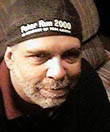|
|
 
|
|
Author
|
Topic: Film Quality on TV
|
|
|
Paul Mayer
Oh get out of it Melvin, before it pulls you under!

Posts: 3836
From: Albuquerque, NM
Registered: Feb 2000
|
 posted 03-05-2006 02:41 AM
posted 03-05-2006 02:41 AM





I'll give this a try. It'll be very generic since I haven't done this kind of work in a long long time.
First, a survey is taken to locate the best prints or elements to use for a transfer session. The chosen element is cleaned and any splices checked. The element can be negative or positive, oneg, IP, IN, or release print. Today's telecines can handle any of these.
Telecines these days use either digital imagers or in some cases flying spot scanners to read the images. I don't think anyone still uses the old camera/projector equipped film chains anymore. Even flying spot scanners are passe now.
Most of the telecines I've seen have PTRs mounted on the feed side and I guess some machines can be equipped with an actual wet-gate to help physically hide scratches.
The telecine does not use an intermittent movement - the film moves through the machine at a constant rate just like tape in a tape machine. That way the machine can handle things like damaged or missing perfs. The scanner raster or imager read pattern changes with the selected linear speed of the film to scan each frame properly as it passes through. Film weave can be held to extremely tight tolerances by scanning the perfs and aligning the images to them. Any remaining weave is probably on the film element itself. Camera weave or image distortion due to film shrinkage can be taken out too during later processing by digitally resizing each frame to some reference frame.
Once the image has been digitally stored on tape or disc drive, the electronic image manipulation starts. To take out any remaining scratches and dirt a DVNR (Digital Video Noise Reduction) device can be used. Care must be taken to not overuse DVNR since certain image artifacts can result. It certainly is not a case of "if a little is good than a lot is better."
Color correction and timing can be adjusted here as well. Generally there are controls for black level, gamma (mid-greys), and gain or white level for each color of RGB or YCM plus master black level, master gamma, and master gain. Usually the machine is set up to render a photographed grey card or chip chart as neutral across the entire range of film density from black to white with the mid-grey level positioned as desired to optimally place the film's D log E curve within the 0 (or 7.5) to 100 IRE video signal range. For instance the mid-grey or gamma level can be set a little lower to help reduce noise in the blacks, or set a little higher to help reveal more picture information in the blacks (black stretch).
By using color matrixing to do any further color adjustment, the grey scale alignment of the machine does not need to be touched, though many colorists do paint each shot using the RGB gains, gammas, and blacks instead of a matrix. On things like video dailies (telecined prints, not the film camera's video tap), I'm not sure if they paint each printed take. For dailies I imagine they do the video equivalent of what the labs call a one-light pass. Set it once and let it fly.
Additional edge and detail enhancement, and additional noise reduction can be done here as well. Again, care must be taken to not use too much enhancement, since that can result in enhanced film grain or very "busy" unnatural looking edges in the image. Such images would also be very hard to digitally compress during DVD authoring.
The intermediate results of all this work can be saved digitally at any time during each session, these days usually in some digital component video format.
Once all of the signal processing is completed, the resulting component video master can be prepped for DVD compression and authoring. The component video master can also be encoded to any of the composite video formats still in wide use.
With proper combing or pre-filtering of the signal prior to encoding, many of the artifacts typically associated with composite video signals like dot crawl, moire, and cross-color effects can be greatly reduced or eliminated. Companies like Vistek, Accom, and Faroudja all made sophisticated encoders that combed very precisely. It's expensive to encode this way, but it pays off with great images even on TVs or monitors equipped with the worst composite signal decoding.
Combing to eliminate composite signal artifacts can be done during decoding in the display, but it is very expensive to do so and therefore simply not done in most consumer displays.
Speaking of displays, the monitors used during the entire transfer process are really something to see. The 19" Sony match monitors I used to work with were wonderful, flat to 10MHz even in the corners with phosphers that produced great grey scales. The Barco and Ikegami match monitors were very good too, but I really liked the Sony stuff. We're talking professional match monitors here ($7000 for a 19" rackmount Sony back in the day), not the consumer stuff. Sony's consumer Trinitron displays were OK but I never liked their phosphors, especially their red which was rather orange instead of a true red.
Anyway this is all very generic I know, but that's the film transfer process in a nutshell.
| IP: Logged
|
|
|
|
|
|
|
|
|
|
|
|
|
|
|
|
|
|
|
|
|
|
|
|
John Pytlak
Film God

Posts: 9987
From: Rochester, NY 14650-1922
Registered: Jan 2000
|
 posted 03-16-2006 03:33 PM
posted 03-16-2006 03:33 PM





About 60% of our visual information comes from in the green portion of the spectrum. So for maximum perceived sharpness, you want the green sensitive layer (magenta dye) on top. Only about 10% of our visual information is in the blue portion of the spectrum, so its position in the emulsion layers is relatively unimportant.
In a color camera film, the sensitivity to red, green, and blue light (white light) is essentially equal. All silver halide film emulsions have a "native" sensitivity to UV and blue light, so a yellow filter layer is needed so the green and red sensitive emulsions don't get exposed by blue light. Therefore, the unfiltered blue-sensitive layer must be on top, with a yellow filter layer underneath to minimize blue light exposure of the red and green sensitive emulsions.
Color print film is exposed by a low color temperature (yellowish) light, and an orange-colored negative. So the blue sensitive layer has to be quite fast compared to the red and green. The speed difference is so great that there is no need to use a yellow filter layer to avoid unwanted blue exposure of the red and green sensitive layers. So you can put the green sensitive layer at the top of the emulsion pack, where it can get the sharpest image during printing. And the blue sensitive layer can be at the bottom, since any sharpness loss due to light scatter is less important.
| IP: Logged
|
|
|
|
All times are Central (GMT -6:00)
|
|
Powered by Infopop Corporation
UBB.classicTM
6.3.1.2
The Film-Tech Forums are designed for various members related to the cinema industry to express their opinions, viewpoints and testimonials on various products, services and events based upon speculation, personal knowledge and factual information through use, therefore all views represented here allow no liability upon the publishers of this web site and the owners of said views assume no liability for any ill will resulting from these postings. The posts made here are for educational as well as entertainment purposes and as such anyone viewing this portion of the website must accept these views as statements of the author of that opinion
and agrees to release the authors from any and all liability.
|

 Home
Home
 Products
Products
 Store
Store
 Forum
Forum
 Warehouse
Warehouse
 Contact Us
Contact Us




 Printer-friendly view of this topic
Printer-friendly view of this topic











![[Big Grin]](biggrin.gif)





